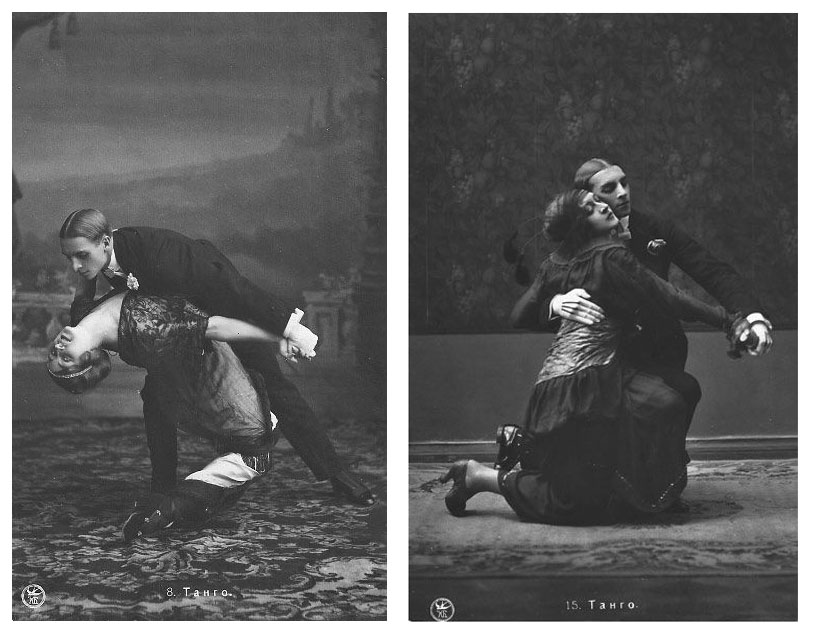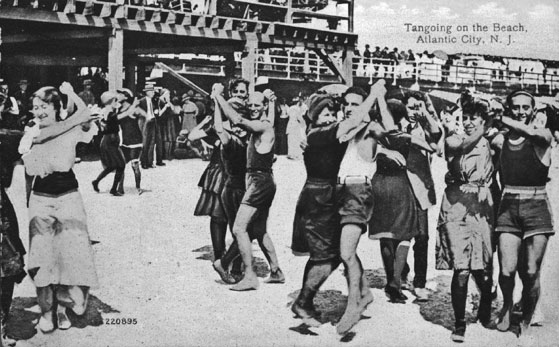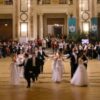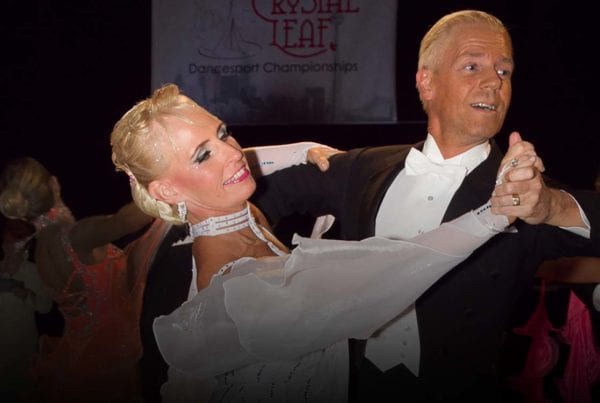Any dancer knows that the Tango is distinctive in its style, and most know that it traces its origins to Argentina. But few ballroom dancers know much about the true history of Tango. And fewer still know about the year the entire world went Tango mad.
Author Mark Knowles has written an excellent book exploring the history of Tango, Waltz and other “scandalous” dances. Thoroughly researched and well documented with an exhaustive bibliography, The Wicked Waltz and Other Scandalous Dances is a great read for anyone interested in the background of these dances. Here are some insights gained from Mark’s research into the development of the Tango. One year in particular stands out in world history as a key marker for ballroom dancing.
The origin of Tango
Surprisingly, the first written use of the word “tango” can found in a document signed by the Spanish governor of Louisiana way back in 1786 and a long way from Buenos Aires. A dance called the Tango was common in Cuba when the island was still a colony of Spain in the early 1800’s. Some have said that when Cuba was fighting for its independence, the families of revolutionaries took refuge in Jamaica, where they introduced the Tango. However, this dance likely had little resemblance to the Tango we know today.
In their book Modern Dancing, Vernon and Irene Castle reported that the Tango is not, as commonly believed, of South American origin. In their words, the Tango is “an old gipsy dance which came to Argentina by way of Spain, where in all probability it became invested with certain features of the old Moorish dances. The Argentines adopted the dance, eliminating some of the reckless gipsy traits, and added to it a certain languid indolence peculiar to their temperament.” Writer Gladys Beattie Crozier concurred, writing in 1913 that the Tango “was carried by the gypsies into Spain, and thence by the Spaniards to the Argentine.”
As Mark explains, in 1870 the Milonga was the popular dance of the day in Buenos Aires. This dance reflected the African tradition of mock battle. The dance was like a ritualized duel, a theme later utilized by dancers as stylized competition and taunting while doing the tango. Buenos Aires became the capital of Argentina ten years later. Thousands flooded to the city from rural areas. Most prominent were the nomadic cowhands, the gauchos. In Buenos Aires, they mixed with immigrants from Spain and Italy who brought with them their own rich cultural heritage. A more urban version of the gaucho, known as compadres, retained qualities of the gauchos such as a fierce independence, masculine pride, and a strong inclination to fight out their disagreements. These rowdy young men played an important part in the birth of the Tango and its unique character.
A more urban version of the gaucho, known as compadres, retained qualities such as a fierce independence, masculine pride, and a strong inclination to fight
A man who called himself Viejo Tanguero, translated as “Old Tangoer,” wrote an article published in Crítica, Buenos Aires’ popular newspaper, claiming the Tango was created as a parody dance by young campadritos, a variation of the popular Milonga that soon found its way to other districts in the city.
The history of Tango moves from Argentina to France. From Buenos Aires, the dance made its way to Paris in 1907 when European entertainment agents discovered the dance while visiting South America.
According to Mark Knowles’ book, Ballroom dancer Maurice Mouvet claimed that he was “the first professional to perform this dance [the tango] in Paris,” in 1908 when he danced it with his partner Leona at the Café des Ambassadeurs. Mouvet explains that he had learned the tango from a group of South American boys who frequented Maxim’s and first introduced the daring dance there.
The Tango Captivates Europe
Paris went completely mad about it. Every club was transformed into a Tango club. Dance schools rushed to understand and teach the dance. Women swooned at the very thought of dancing so closely to their partner, but couldn’t wait to get back to the dance floor to dance it again.
As the Tango craze grew in France, word of the dance filtered to other cities in Europe. Around 1910, the British first heard of the sensual new dance. After the summer of 1911, when English tourists vacationing in France returned home, they began asking about the dance they had seen abroad. The same year, the Dancing Times ran pictures of the Tango. Afternoon Tango teas came into vogue, and London, like other cities across Europe, was gripped by tangomania.

Tango postcards from Russia, 1914
Tango Mania takes over the world
By 1913, practically every hotel and restaurant offered Tango dances. Society hostesses offered private Tango teas in their homes. The Savoy Hotel offered a special tango dinner each evening. The Tango infiltrated every level of British society, from the wealthy to the working classes. Even street urchins danced the Tango on London’s street corners for pennies. Viscount Haldane, the Lord Chancellor of London, lamented that low numbers of enlisted men in the Territorial Army was largely due to young men preferring to spend their time dancing the Tango, rather than serving their country. Germany also went mad over the new dance. Tango teas and classes offering instructions in the dance popped up around the country.
In Russia, Tsar Nicholas II ordered a demonstration of the Tango after he learned that two of his nephews, as Mark puts it, “had been involved in an incident in a fashionable nightclub in St. Petersburg, ‘where a new perturbing dance was revealed.’” The grand-dukes showed their uncle the Tango and “perhaps surprisingly — he liked it.” One magazine in St Petersburg ran the headline “Everybody’s Dancing the Tango.”

Tangoing on the Beach in Atlantic City in the early 20th Century
America gets into it
That winter the Tango hit the USA in full force. Cities across America were swept up in Tango madness. The Lincoln Daily Star, in Lincoln, Nebraska, reported on October 5, 1913: “Tango-itis, in cyclonic velocity, is sweeping across the country, and almost the entire world for that matter.” On February 16, 1914 the Oelwein Daily Register in Iowa ran an article “Tango Mania Has New York in its Grip.” There were Tango shoes, Tango clothing, Tango hairstyles, Tango hats, even attention to makeup specifically for Tango.
The social reporter of the Evening Chronicle in Marshall, Michigan, summed up the all-encompassing fascination with tango fashions of the day by stating, “Just because everybody’s mad about Tango, they must needs have their wardrobe rebuilt to meet the requirements of the aforesaid Tango. So they wear Tango slippers, Tango corsets, Tango gowns and Tango lingerie. And that’s not all. They wear those things in the original Tango shade. For it’s Tango, Tango, Tango, and nothing but Tango from alpha to omega. So far, no one can predict just how far the Tango craze will effect [sic] milady’s wardrobe; but if it has so violent an effect upon her wardrobe as it has upon her festivities, it will be all Tango, wholly Tango, and nothing but Tango. For that’s the last word of the hour. And the world has apparently gone Tango mad.”
For it’s Tango, Tango, Tango, and nothing but Tango from alpha to omega… the world has apparently gone Tango mad
The reaction
As the world rushed to embrace the Tango, an equally strong reaction came from those who thought it vulgar and obscene. The Pope and other religious leaders condemned the Tango. Newspaper editorials began to speak out against the dance and cities even began to outlaw the Tango as being too vulgar for proper society. By April 12, 1915, five Tango teachers in Paris were issued decrees of expulsion from the city for disobeying a ban against the dance. As Mark so succinctly puts it, Paris, the very city that was recognized as having launched the Tango craze, had now turned its back on the dance. Some health experts even suggested that because of all the new steps they had to learn, women were suffering from too much strain on their brains.
Within one year, the world went from being Tango mad to rejecting this dramatic and sensuous dance. Across the US, cities banned the Tango. The Massachusetts state legislature considered a bill making it a crime to dance the Tango. The penalty for breaking the law was a $50.00 fine for the first offence and six months in jail for the second. Mayor Fitzgerald of Boston issued orders for a policeman and matron to stand guard at every dance hall to see that the Tango was not danced. He announced that any establishment allowing the dance would have its license revoked. Dance halls put signs in their window indicating that this was a “Respectable dance school” and thus no Tango would be found inside.
Dance halls put signs in their window indicating that this was a “Respectable dance school” and thus no Tango would be found inside
The outbreak of World War 1 further dampened enthusiasm for the Tango. However, during the war years, Argentina began releasing a series of films that featured the Tango. These continued for some time to keep interest in the Tango alive, at least in South America. The films included Nobleza Gaucha (1915), Flor de Duranzo (1915) El Tango de la Muerte (1917) and Rudolph Valentino’s famous silent film The Four Horsemen of the Apocalypse (1921). The dance did reemerge again full force in the 1920’s renamed the “New French Tango.”
Today we have the Argentine Tango, the American Smooth Tango and the International Style Tango. Each one has its unique strengths and weaknesses. They are all spectacular when performed with passion, connection and skill.
You may also like: Rudolph Valentino’s Tango scene













Weaknesses of Argentine Tango? Would like to know…
Every dance has strengths and every dance has some areas where it isn’t ideal. I love Argentine Tango. It’s sexy and powerful and beautiful to watch. But it’s designed as an intimate experience between one couple. It’s perfect as a show dance where one couple is performing for an audience, or just for their own intimate connection (on a beach for example). You can’t put a dozen couples on a floor all dancing different AT routines and experience the magic of that dance. You would lose all the power it conveys because the intimacy can’t be shared when your attention is divided like that. In contrast, you can easily have a dozen International Tango couples on the floor and enjoy the spectacle of that multi-faceted display of different routines because they have a different purpose and character than the Argentine Tango.